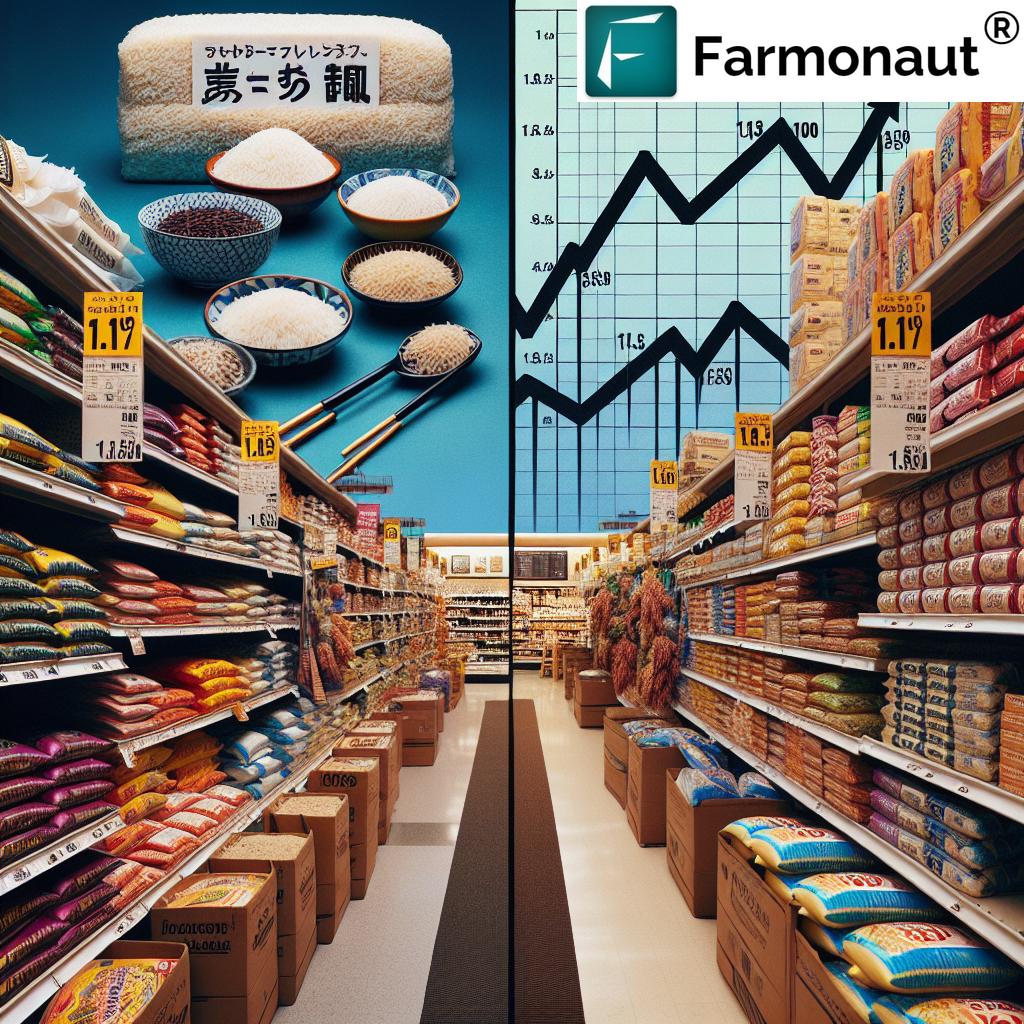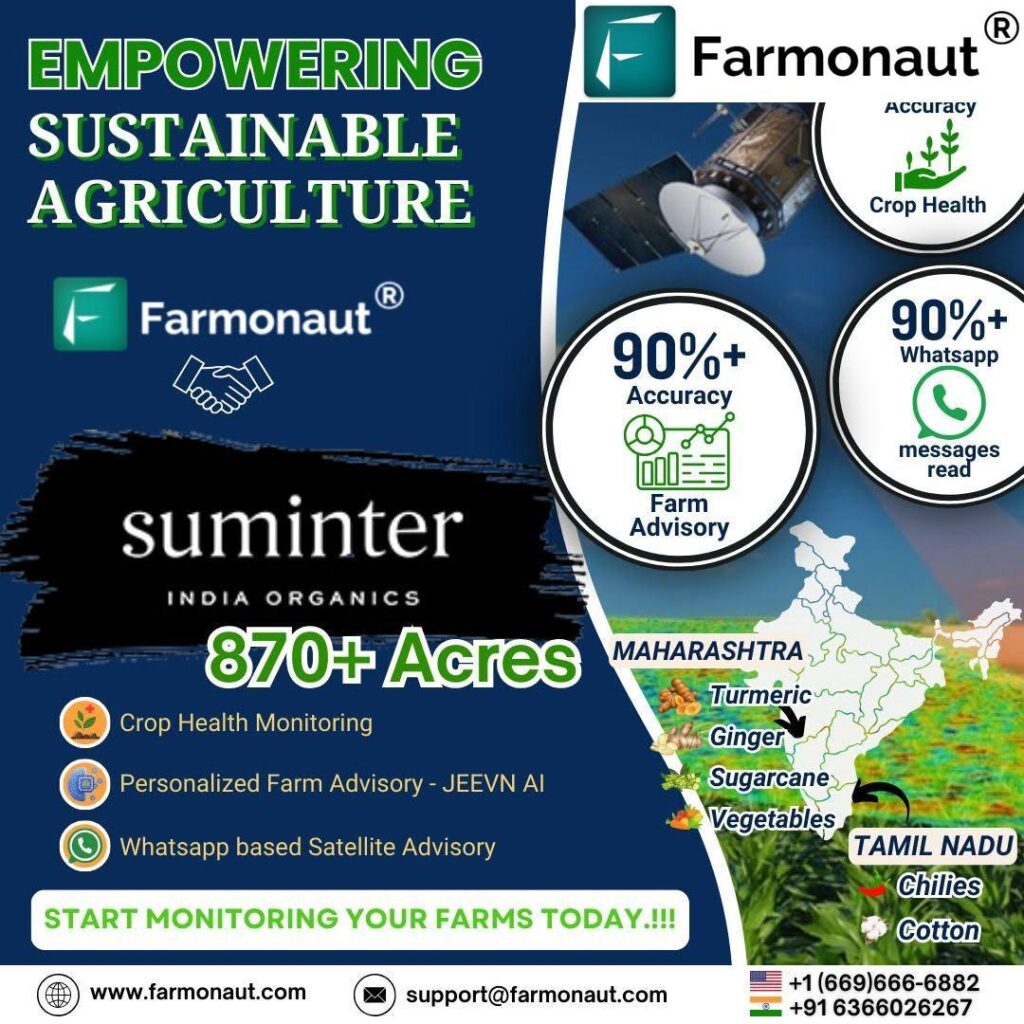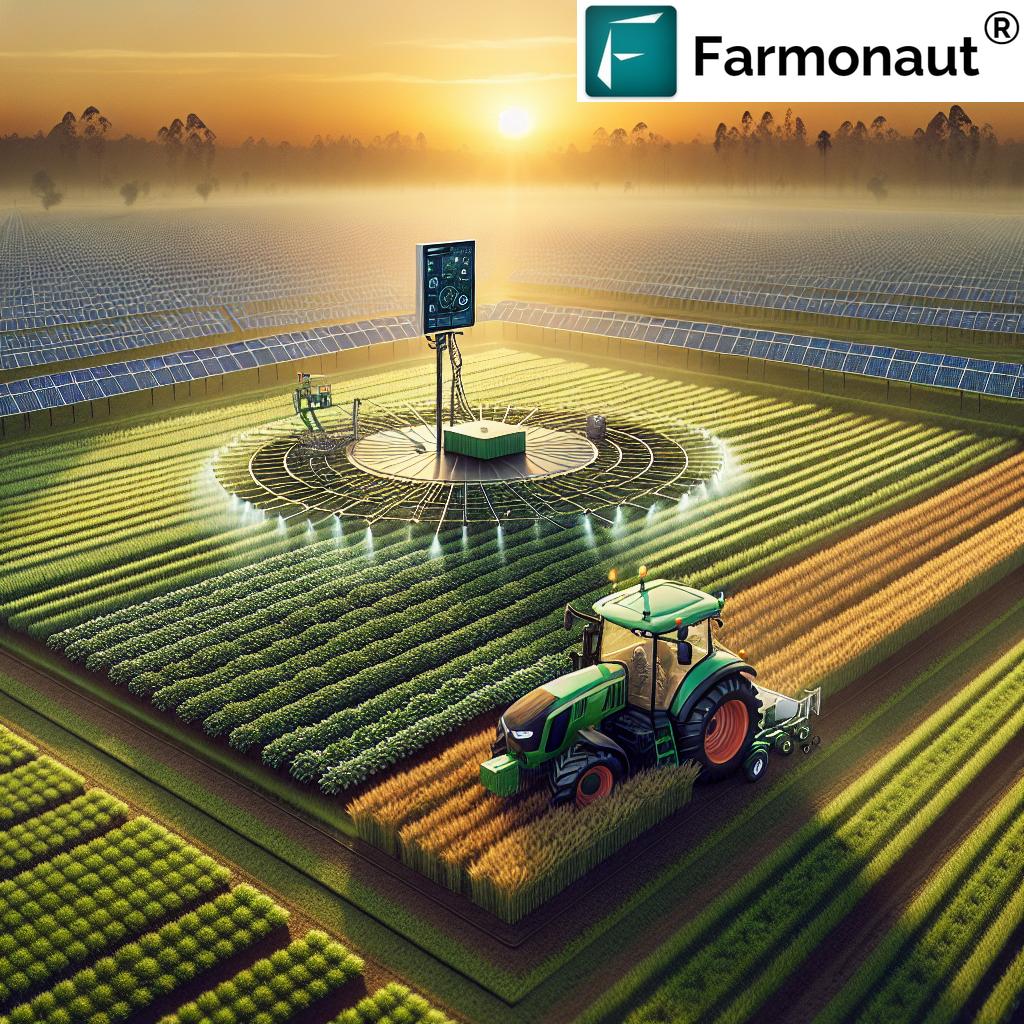Japan Farming 2025: Rice & Agriculture Trends – Tradition, Technology & Tomorrow
“By 2025, over 60% of Japanese rice farms are expected to use precision agriculture technologies.”
“Japan’s agricultural robot market is projected to reach $1.2 billion by 2025, driving modernization in rice farming.”
- Table of Contents
- Overview: Understanding Japan Farming in 2025
- Historical Significance & Cultural Backbone of Japan Rice Farming
- Japanese Rice Paddies: Landscapes, Terraces, & Traditional Ethos
- Modern Challenges Facing Farming in Japan
- Technological Innovation in Japanese Agriculture (2025 & Beyond)
- Japan Rice Farming: AI, Automation, and Drones
- Sustainable Farming Practices and Environmental Impact
- Japanese Agriculture, Rural Communities & Rural Tourism
- The Future of Japan Farming: Policy, Crop Breeding, and Food Security
- How Farmonaut Supports Modern Japan Farming
- Comparison Table: Traditional vs. Modern (2025) Rice Farming Practices in Japan
- FAQs: Japan Farming and Future Prospects
Overview: Understanding Japan Farming in 2025
Japan farming in 2025 is at the crossroads of age-old tradition and rapid modernization. This country remains an exemplar when it comes to blending cultural practices with advanced technologies, particularly in rice cultivation. Farming in Japan is not just about food production—it represents a way of life, the foundation of rural livelihood, economic resilience, and a core component of national identity.
As we move further into the decade, japan faces profound demographic challenges and labor shortages, yet its agricultural sector adapts by prioritizing new technologies. The focus on sustainable agriculture, rural revitalization, and food security shapes public and private efforts alike. Modern innovations, including drones, robotics, and sophisticated water management systems, are reshaping the landscape of japan rice farming.
Historical Significance & Cultural Backbone of Japan Rice Farming
The story of agriculture farming in Japan is deeply rooted in the nation’s history, where rice has been both the backbone and cornerstone of society. For centuries, japanese rice—especially premium varieties like Koshihikari—has influenced culinary traditions, annual rituals, and community identity. Rice is more than a crop; its planting and harvesting mark significant social events and reflect the enduring connection between the people, land, and water.
Traditionally, rice farming in Japan involved collaborative labor through systems like “yui” (collective community work), ensuring each family could plant and harvest despite the country’s limited arable land. This cooperative approach reinforced bonds among rural communities and fostered the ethos of mutual support—the very fabric of Japanese agricultural identity.
Japanese Rice Paddies: Landscapes, Terraces, & Traditional Ethos
Despite Japan’s relatively small landmass and predominance of mountainous terrain, the Japanese have long excelled in efficient use of arable land. Most rice paddies are situated in terraced fields, turning slopes into productive agricultural assets. This practice not only maximizes space but helps regulate irrigation, mitigate flood risks, and demonstrate a sustainable, community-centric approach to farming in Japan.
- Terraced Rice Fields: Especially prevalent in Niigata, Wakayama, and Toyama prefectures, these fields embody the harmony between human activity and nature.
- Paddies and Water Management: Japanese rice irrigation is an art, with networks of canals and levees carefully managed by generations of farmers.
- Land Conservation: Preserving soil health is intrinsic to maintaining paddies year after year.
This landscape-driven approach to japan farming reflects not just technical skill but a profound respect for the environment and ancestral wisdom.
Modern Challenges Facing Farming in Japan
Despite its enduring cultural and economic significance, japan farming faces significant challenges in 2025—many of which are rooted in demographic shifts:
- Aging Population: The average age of Japanese farmers now exceeds 67, with many over 70.
- Declining Rural Workforce: Young people are migrating towards urban centers, creating a labor gap.
- Small Farm Sizes: Fragmented plots—often fewer than 2 hectares each—make it difficult for farmers to achieve economies of scale or invest heavily in new machinery.
- Profitability Concerns: With rising input costs and global competition, many traditional farmers struggle to maintain profitability and sustain their livelihoods.
The Japanese government has responded with policies that encourage farm consolidation, modernization, and adoption of advanced technology. These steps aim to:
- Boost Productivity through efficient resource use and technological upgrades
- Ensure Food Security within the country, reducing dependency on imports
- Revitalize Rural Communities by making farming a more attractive and viable career, particularly for youth
These policy changes are rapidly transforming the landscape of agriculture farming in Japan.
Technological Innovation in Japanese Agriculture (2025 & Beyond)
One of the most striking trends in modern Japan farming is the integration of advanced technologies across all stages of crop production, especially in rice cultivation. These technological advances help address labor shortages, improve yields, and minimize environmental impact.
Precision Agriculture and Drones: Optimizing Japanese Rice Fields
Precision agriculture—a hallmark of modernization in Japan—centers on using real-time data to optimize the use of inputs (seeds, fertilizer, water) for maximum efficiency. Key innovations shaping japan rice farming include:
- Drones: Used for crop monitoring, aerial spraying, and mapping, drones significantly cut labor time and enable accurate, site-specific management.
- Remote Sensing and Satellite Imagery: With platforms like Farmonaut Large Scale Farm Management, farmers and businesses can monitor:
- Vegetation health
- Soil moisture
- Crop growth patterns
- Potential pest or disease outbreaks
- Data-Driven Decision Making: Real-time data minimizes guesswork, ensuring that resources are used responsibly while maximizing output.
Smart Machinery, Robotics & Automation: Responding to Labor Shortages
Automation is revolutionizing rice farming. GPS-guided tractors, robotic transplanters, and automated harvesters have now become widespread, especially among larger commercial farms and agricultural cooperatives. These technologies in japan farming:
- Reduce manual labor requirements by up to 30%–50%
- Enable consistent operations and higher precision, even in challenging weather or terrain
- Support elderly or less physically able farmers, extending their productive years
- Facilitate planting, transplanting, weeding, fertilizing, and harvesting with minimal human oversight
As robotics in japan rice farming continues to evolve, it is expected to play an even larger role by 2025 and beyond.
Greenhouses, Vertical Farming, and Controlled-Environment Agriculture
Japan is a global leader in greenhouses and vertical farming facilities. While rice paddies remain central, these controlled environments are used for year-round production of vegetables and fruits with:
- Minimal pesticide use
- Precise climate and water management
- Efficient land use, even in urban or peri-urban areas
- Highly traceable and hygienic produce, meeting consumer demand for safe, high-quality food
These innovations add resilience and diversity to japan’s agricultural sector, helping mitigate the risks posed by climate change and fluctuating markets.
Japan Rice Farming: AI, Automation, and Drones in 2025
The integration of AI, robotics, and big data analytics is perhaps the most transformative development in japan rice farming by 2025. These technologies are embedded at every level:
- AI-Guided Farm Operations: Advanced AI systems analyze weather, soil, and satellite data to optimize irrigation and fertilization schedules. Platforms like the Jeevn AI Advisory System empower farmer decision-making.
- Automated Machinery: Robotic rice transplanters plant seedlings at optimal spacing and depth, while self-driving harvesters maximize efficiency and minimize waste.
- Crop & Disease Monitoring: AI detects early signs of nutrient deficiencies or disease outbreaks, helping to target interventions and reduce chemical inputs.
- Blockchain for Traceability: Ensures that every step of rice production, from planting to distribution, is transparent—critical for food safety and consumer trust. Explore Farmonaut’s product traceability services for more details.
By 2025, these advancements make it possible for smaller farms—historically a challenge for rice farming in Japan—to access enterprise-level analytics and automation, reducing the management burden and labor cost.
Sustainable Farming Practices and Environmental Impact
Sustainability has become a core theme in agriculture farming in Japan. With environmental concerns mounting and consumer demand shifting toward ethical products, the sector’s transformation is defined by a commitment to eco-friendly approaches.
Water Management: Innovation & Conservation
Rice farming relies on careful water management. In 2025, Japan is leveraging both traditional irrigation wisdom and advanced precision systems:
- Networked paddies with recycle-and-reuse systems for maximum water efficiency
- AI-powered irrigation models—such as those available via platforms like Farmonaut—offering real-time recommendations to minimize waste and maximize crop health
- Monitoring of NDWI (Normalized Difference Water Index) for hydrological insights, helping maintain a balanced ecosystem in paddies
Such approaches help farmers adapt to changing rainfall patterns, ensure food security, and protect the environment.
Organic Farming, Biodiversity, and Soil Health
There’s a growing trend towards organic farming and reduction of chemical inputs in japan farming:
- Biological pest management techniques—using ducks in paddies or native plant covers
- Crop rotation and intercropping to improve soil structure and fertility
- Minimal use of synthetic fertilizers and pesticides, supported by targeted application through precision agriculture
These environmentally sustainable practices not only protect Japan’s already precious land and water resources but also align with both global targets and shifting domestic consumer values.
To further support sustainability, platforms like Farmonaut’s Carbon Footprinting provide actionable data on agricultural emissions and carbon sequestration. This helps farmers, businesses, and policy makers track their environmental impact and improve their footprint.
Blockchain Traceability for Food Safety & Trust
In a world where consumers value transparency, blockchains are transforming how japan rice farming products reach the market. Every step—from seed selection to milling, packaging, and shipment—is logged on an immutable ledger. This addresses food fraud, boosts overseas trust, and enhances the global reputation of Japanese rice.
Farmonaut’s traceability suite is designed for businesses, cooperatives, and government entities seeking complete transparency in agricultural supply chains.
“Japan’s agricultural robot market is projected to reach $1.2 billion by 2025, driving modernization in rice farming.”
Japanese Agriculture, Rural Communities & Rural Tourism
In response to rural depopulation and urban migration, Japan is developing new models of rural engagement:
- Farm Stays & Agritourism: Short-term stays and hands-on farming experiences immerse visitors in rice cultivation, fostering urban-rural ties and bringing supplementary income to communities.
- Education & Cultural Preservation: These programs help pass down traditional rice-farming wisdom while demonstrating the value of modern techniques to the next generation.
- Community Supported Agriculture (CSA) and Direct-sales: Farmers sell produce directly to urban consumers via web platforms and mobile apps, such as those enhanced by advanced logistics management technologies like Farmonaut’s Fleet Management.
This multi-pronged approach helps keep rural communities resilient and ensures that the story of agriculture farming in Japan continues to evolve.
The Future of Japan Farming: Policy, Crop Breeding, and Food Security
Government Policies, Innovation, and Modernization
The Japanese government continues to champion transformation in the agriculture sector through:
- Subsidies for machinery, precision agriculture tools, and farm consolidation
- Research funding for universities and private companies working on climate-resilient crop varieties
- Policies incentivizing late-career farmers to mentor younger entrants and facilitate smooth land transitions, offering tax benefits for farm amalgamation
- Promoting the use of smart farming technologies by lowering barriers to access (including mobile apps and multilingual support)
Looking beyond 2025, these policies seek to build a resilient, innovative, and globally competitive food system rooted in both tradition and technology.
New Rice Varieties: Climate Change and Pest Resistance
As climate variability increases, rice breeders in Japan are racing to develop new varieties that can thrive under unpredictable conditions:
- Drought- and flood-tolerant rice lines, ensuring stability amidst irregular weather
- Pest- and disease-resistant cultivars, minimizing losses and reducing chemical use
- Efforts to enhance eating quality (aroma, texture, nutritional value), keeping Japanese rice globally competitive
These advanced genetics, when combined with precision agriculture and robust traceability, will define the next chapter in japan rice farming.
Supply Chain Modernization and Worker Safety
New technology is improving logistics for the delivery of rice and other produce from rural regions to Japan’s urban centers:
- Smart mapping and tracking of shipments for better freshness and reduced spoilage
- Integration of satellite-based monitoring systems—like Farmonaut—for real-time fleet tracking and logistics optimization
- Ergonomic automation in farming reduces physical strain and supports an aging workforce
The result: safer, more reliable deliveries, improved food security, and sustained economic viability.
How Farmonaut Supports Modern Japan Farming
At Farmonaut, we empower farmers, businesses, and government agencies with advanced satellite-based solutions for precision agriculture, supply chain monitoring, and resource management—making agriculture farming in Japan smarter and more sustainable.
Our Platform Features
- Satellite Crop Monitoring: Access high-resolution, multispectral imagery for vegetation health (NDVI), soil condition, and disease alerts—enabling rapid, data-driven decisions and maximizing productivity.
- AI-Based Advisory: Jeevn AI delivers customized insights and weather forecasts, helping plan irrigation, fertilization, and pest management.
- Blockchain Traceability: We make it easy to prove product authenticity and facilitate safe, transparent trading with global buyers.
- Fleet Management: Our tools optimize logistics for efficient delivery and reduce carbon footprints. Learn more.
- Environmental Impact Tracking: Real-time tools for monitoring carbon emissions and resource use, supporting compliance with Japan’s sustainability goals. See Farmonaut’s Carbon Footprinting.
- API Integration: Developers and businesses can build custom apps with the Farmonaut API and access comprehensive docs.
With Farmonaut’s platform, anyone in Japan can leverage the full power of satellite intelligence for field mapping, resource tracking, and supply chain analytics—affordably and at scale.
Comparison Table: Traditional vs. Modern (2025) Rice Farming Practices in Japan
| Aspect | Traditional Practices | Modern Practices (Estimated for 2025) | Estimated Impact/Outcome |
|---|---|---|---|
| Land Preparation | Manual plowing, community labor | Automated tractors, GPS-guided machinery | Up to 50% reduction in preparation time |
| Irrigation | Open canal irrigation, manual gate control | Automated, AI-powered irrigation, water recycling systems | 20-35% water savings, increased precision |
| Pest Management | Periodic pesticide spraying, duck releases | AI-driven disease prediction, drone-based targeted application, biological controls | Reduced chemical usage by 25-40%, better ecosystem health |
| Yield per Hectare | ~6 tons/ha (average) | ~8 tons/ha (estimated with tech adoption) | ~30% increase in output |
| Labor Intensity | High, many manual tasks | Automated transplanting & harvesting, remote monitoring, robotics | 30-50% reduction in labor hours |
| Environmental Impact | Variable, often high emissons and moderate biodiversity | Carbon tracking, traceability, organic methods, precision resource use | Lower emissions, improved biodiversity, better soil health |
| Traceability | None or paper records | Blockchain-powered digital traceability | Enhanced consumer trust, food safety, and export competitiveness |
| Supply Chain | In-person delivery, small-scale transport | Smart fleet management, real-time tracking | Faster, fresher, more reliable deliveries; reduced spoilage |
FAQs: Japan Farming and Future Prospects
1. Why does rice farming remain so important in Japan?
Rice is deeply embedded in Japan’s culture and economy. It shapes cuisine, rituals, and rural livelihood, serving as both a staple food and a source of community pride. Even with advances in technology, rice farming remains a core element of national identity.
2. What are the biggest challenges in japan rice farming?
The sector faces significant labor shortages due to an aging rural population and youth migration to urban centers. Farm profitability is challenged by small land sizes, rising costs, and climate change. However, modernization and policy support are helping to address these challenges.
3. How is technology transforming rice farming in Japan in 2025?
Through precision agriculture, automation, robotics, and AI, farmers can monitor fields remotely, apply resources more efficiently, and reduce manual labor. Blockchain enhances traceability and food safety. These tools, available via platforms like Farmonaut, help optimize productivity and sustainability.
4. What role does sustainability play in modern Japanese agriculture?
Sustainability is now central to all farming practices. Emphasis is placed on water conservation, soil health, and biodiversity through organic farming, precision irrigation, and environmental tracking. These initiatives support both global environmental goals and rising consumer expectations for traceable, healthy food.
5. Can small farms in Japan successfully adopt new technologies?
Yes. While adoption is faster among larger cooperatives, affordable tools like Farmonaut’s satellite imagery, AI-powered decision support, and resource management modules are designed to make advanced japan farming accessible for all farm sizes.
6. How does Farmonaut facilitate modernization in japanese rice farming?
Our platform offers real-time crop monitoring, environmental impact tracking, AI advisory, product traceability, and resource management. These features help farms of all sizes succeed in the evolving landscape of japan farming, now and for the future.
Ready to Transform Your Farm? Get Started with Farmonaut Today
Farming in Japan is undergoing a renaissance, shaped by tradition, innovation, and a deep respect for land and water. Whether you are a smallholder or manage an extensive operation, Farmonaut provides the satellite intelligence, AI, and blockchain solutions to keep your farm competitive, sustainable, and future-ready—for 2025 and beyond.
Farmonaut Subscriptions
In summary: Japan farming in 2025 is defined by a unique blend of tradition and innovation. Through technological integration—embracing AI, robotics, and precision agriculture—Japanese rice farming overcomes demographic and environmental challenges, ensuring the sector remains resilient, productive, and sustainable. We at Farmonaut are honored to support this transformation, empowering all stakeholders in Japanese agriculture to thrive in the modern era while preserving a rich cultural legacy.












